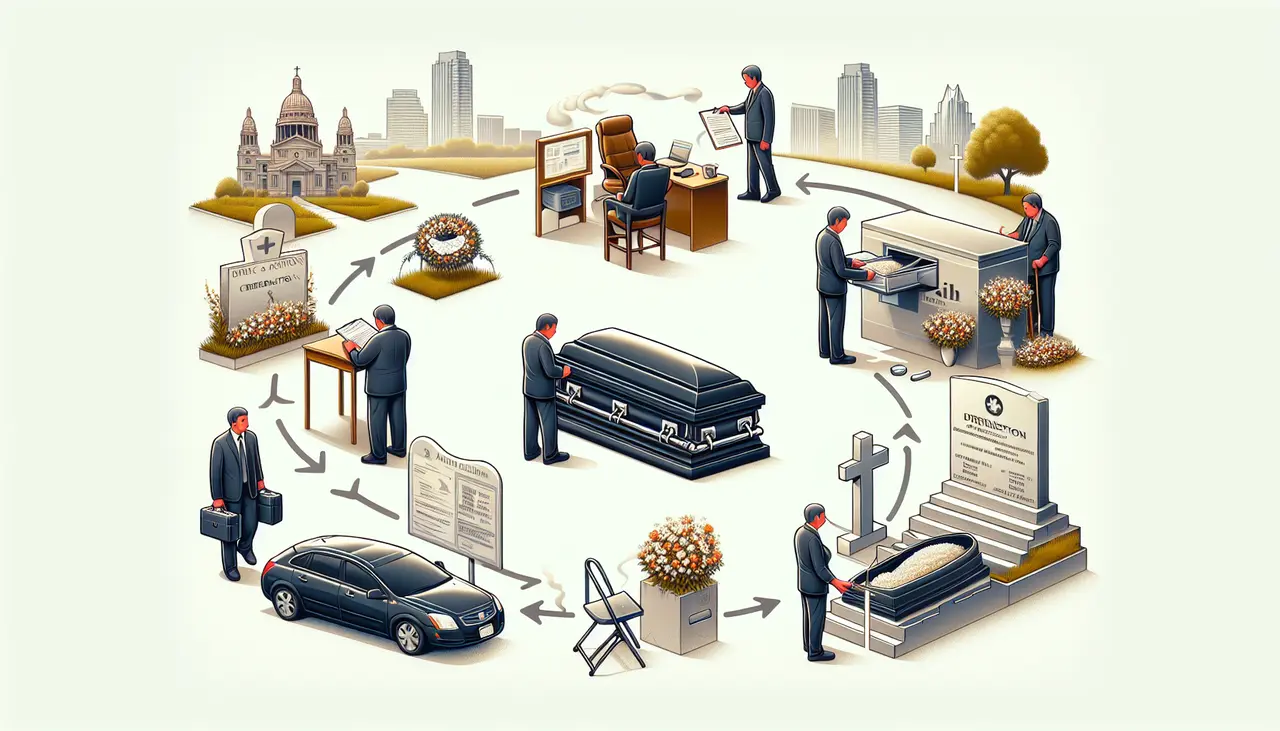Understanding Direct Cremation Services: An Overview
Direct cremation is the simplest form of cremation service you can opt for in Austin. It involves the cremation of the deceased without a formal funeral service beforehand. Here’s the straight talk: Direct cremation means no viewing, visitations, or ceremony at the crematorium. After the body is cremated, the remains, often referred to as ashes, are returned to the family. You might be wondering about the cost. It varies but is generally considered to be more affordable than traditional burial services. Why? Because you’re cutting out the expenses of a funeral ceremony, embalming, and a fancy casket. Essentially, if you’re leaning towards a no-frills, straightforward approach to after-life care, direct cremation in Austin could be the way to go. It allows families to manage costs effectively while still respecting their loved one’s memory. Keep this in mind: while direct cremation strips down some of the traditional aspects, the dignity and respect for the deceased remain intact. And remember, after direct cremation, you have the flexibility to plan a memorial or other tribute at a time and place that suits the family, without the immediate pressure a traditional service might impose.
The Initial Steps: How to Begin Planning a Direct Cremation in Austin
Starting the planning process for a direct cremation in Austin can feel overwhelming, but breaking it down into manageable steps can help. First and foremost, you’ll need to find a reputable cremation service provider. Look for ones that have positive reviews, transparent pricing, and a good track record in the community. Next, you’ll want to contact the provider and ask about their process, prices, and any packages they offer. Be clear about wanting a direct cremation, which is the most straightforward and cost-effective option, where the body is cremated shortly after death without a formal funeral service. Then, discuss and decide on the details like the urn type, whether you want any services or memorials, and how the ashes will be returned to you. Remember, starting with these steps will guide you through the planning process smoothly and help ensure your loved one’s final wishes are respected in a dignified manner.
Choosing a Direct Cremation Provider: What to Look For
When picking a direct cremation provider in Austin, keep it simple but be smart. Look for these key things: Reputation, price, and services. A provider’s reputation is like a report card. Check online reviews and ask locals. You want someone trusted. Price matters but watch for hidden costs. Direct cremation should be affordable. Expect to pay around (600 to )2,000 in Austin. Services should be straightforward. You need a provider who does the essentials without pushing extras you don’t want. Lastly, ask about the process. You want a provider who keeps you informed and makes this difficult time a bit easier. Stick to these points, and you’ll find the right fit.
The Legal Requirements for Direct Cremation Services in Texas
In Texas, there are specific legal requirements you need to follow for direct cremation services. First, before anything can happen, the death must be legally registered with the local or state vital records office. This is a must-do, no exceptions. After that, you need to obtain a death certificate, and let’s be clear, you’ll likely need several copies for closing accounts and settling affairs.
Now, talking about direct cremation, Texas law states that you must wait at least 48 hours after the death before the cremation can take place. No rushing here—this is a strict rule. But, if you’re in a hurry for some reason, you can get a waiver from a justice of the peace or medical examiner in the county where the death occurred. That’s your only shortcut.
Also, you don’t necessarily need a casket for direct cremation in Texas. If you opt for one, though, any kind will do, even a simple cardboard one. The state’s take on this? It’s all fine as long as it’s combustible.
Lastly, while not a legal requirement, it’s smart to work with a funeral home or cremation service that knows their stuff and respects these laws. They handle the paperwork so you can focus on what matters—saying goodbye in your way. Keep it straightforward, keep it respectful, and make sure you’re ticking off these legal boxes. It’s the Texas way.
Preparing for the Direct Cremation: Required Documents and Permits
To arrange a direct cremation in Austin, you need to get some paperwork in order first. It’s not as complicated as it sounds. Just a few steps. First, you’ll need a death certificate. This is a must-have. You can obtain it from the local registrar or the health department. Make sure to get several copies; you’ll need them for other formalities too. Next up, you will need a Cremation Authorization Form. This one’s critical. It’s a green light for the cremation to go ahead, and it must be signed by the next of kin or the legal representative of the deceased. Don’t forget about the permit for Disposition of Human Remains. Yes, it’s a bit of a mouthful, but it’s essentially the go-ahead from the county allowing for the cremation to take place. These documents are your key ingredients for a direct cremation. Gather them, and you’ll be set to move forward. Simple, right? Keep it straightforward, follow these steps, and you’ll navigate through the paperwork maze with ease.
Direct Cremation Costs: What to Expect and Budgeting Tips
Direct cremation in Austin skips the fancy services, making it more budget-friendly. You’re looking at spending around (600 to )1,200 on average. This cost usually covers the pickup of the body, the cremation process, and the return of the ashes in a basic urn or container. Don’t get caught off guard by hidden fees. Ask for a complete breakdown upfront. To keep costs down, consider buying your urn online or using a family heirloom. And if you’re thinking about a gathering, hosting it at home or in a free community space can save a bundle. Remember, prices can vary based on the provider, so shop around and compare services to find the best deal for your budget.
Optional Services to Consider When Planning a Direct Cremation
When planning a direct cremation in Austin, you have the option to keep it simple or add services to make it more personalized. Direct cremation is the most basic form, where the body is cremated shortly after death without a funeral service. However, you can choose to add optional services based on your preferences and budget. One popular option is hosting a memorial service or celebration of life at a later date. This can be anywhere that holds significance to you or the deceased, from a family home to a favorite park. Another choice is selecting unique urns or keepsakes for the ashes. These come in various styles and materials, allowing for a personal touch. You might also consider arranging a viewing or visitation before the cremation. While not common with direct cremation, some families find closure in saying their goodbyes this way. Additionally, think about creating online memorials or tribute videos. These digital platforms let friends and family share memories and condolences from anywhere. Lastly, don’t forget about personalization options such as engraving urns or creating memory books. These services add costs but can offer significant value in honoring a loved one’s memory. Remember, the choices you make should reflect the wishes of the deceased and the needs of those left behind.
How to Personalize a Direct Cremation Service in Austin
Personalizing a direct cremation in Austin means making the service unique to your loved one, reflecting their personality, values, and life lived. Here’s how you can do it:
First, think about what made the person special. Was it their love for music? Consider playing their favorite songs during the service. If they were passionate about nature, you might scatter their ashes in a beloved park or garden. The idea is to capture the essence of who they were.
Next, involve family and friends. Ask them to share stories, photos, or even write letters to the departed. This collective remembrance adds a deeply personal touch and helps everyone feel connected.
Consider creating a memory board or a digital slideshow of photos and significant moments in their life. This visual element can serve as a focal point during the service, allowing those present to reflect on the good times and the impact the person had on their lives.
Lastly, think about keepsakes. Sometimes, personalizing a service can be as simple as giving attendees a small memento to remember the day and the person. This could be something as straightforward as a custom bookmark, a seedling to plant in their memory, or a piece of jewelry that incorporates their ashes.
Remember, there’s no right or wrong way to personalize a direct cremation service. It’s all about honoring your loved one in a way that feels right to you and your family.
After the Cremation: Options for the Ashes
After the cremation, you have a few choices on what to do with the ashes. Some folks keep them in an urn at home. You can buy an urn that fits your style or even have one custom-made. Another option is scattering the ashes in a place that was special to the person. This could be a park, the ocean, or anywhere meaningful. Just make sure you check the local rules about scattering ashes. There’s also the choice of burying the ashes in a cemetery plot or placing them in a columbarium, which is a space with niches for urns. Lastly, if you’re looking for something unique, you can turn the ashes into jewelry, art, or even plant them with a tree. Each option honors the person in its way. Pick what feels right for you and your family.
Dealing with Grief: Resources and Support After a Direct Cremation
Grief hits hard and in unpredictable ways after the loss of a loved one. Direct cremation, though simpler and often chosen for being more straightforward and affordable, doesn’t lessen the emotional burden. In Austin, many resources and support systems are available to help you navigate through this challenging time. First off, consider joining a local support group. These groups offer a sense of community and understanding that can be incredibly comforting. The Austin Hospice provides grief support groups that are open to everyone, not just families of those who received care there. Online platforms can also be a valuable resource. Websites like GriefShare feature directories of local and virtual grief support groups. Additionally, many find solace in one-on-one therapy. Austin has numerous therapists specializing in grief counseling. Organizations such as the Capital Area Counseling offer sessions on a sliding scale based on income, making it accessible to everyone. Remember, moving through grief is not about forgetting your loved one but finding a way to carry their memory with grace. Seeking help is a sign of strength and a step towards healing.







